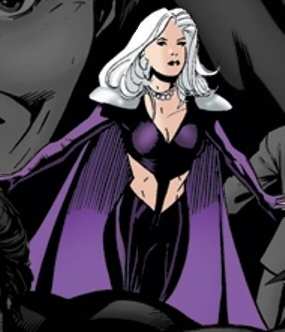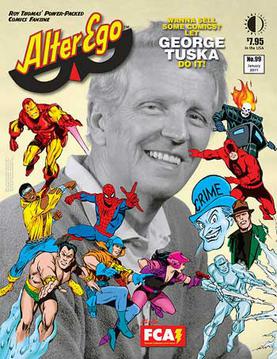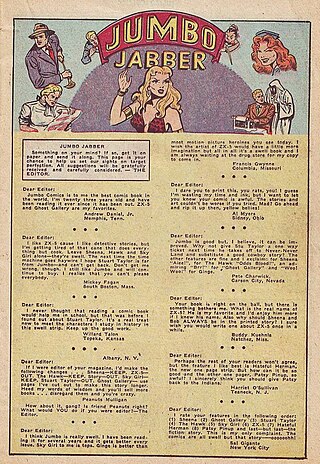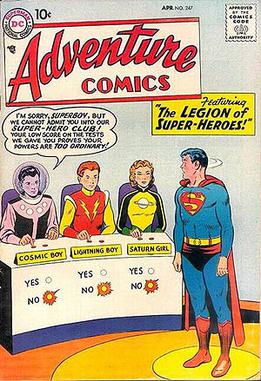Related Research Articles

A fanzine is a non-professional and non-official publication produced by enthusiasts of a particular cultural phenomenon for the pleasure of others who share their interest. The term was coined in an October 1940 science fiction fanzine by Russ Chauvenet and first popularized within science fiction fandom, and from there the term was adopted by other communities.

The Legion of Super-Heroes is a fictional superhero team appearing in American comic books published by DC Comics. Created by writer Otto Binder and artist Al Plastino, the Legion is a group of superpowered beings living in the 30th and 31st centuries of the DC Comics Universe, and first appeared in Adventure Comics #247.

Princess Projectra is a fictional character, a superheroine in the DC Comics universe. Typically portrayed as a haughty member of an alien royal family, she is from the 30th and 31st centuries and is a member of the Legion of Super-Heroes.
An amateur press association (APA) is a group of people who produce individual pages or zines that are sent to a Central Mailer for collation and distribution to all members of the group.
Carl Gafford is a colorist who has worked for several decades in the comics industry. His career has spanned several publishers, including Marvel Comics, DC Comics and Topps Comics.
The Grand Comics Database (GCD) is an Internet-based project to build a database of comic book information through user contributions. The GCD project catalogues information on creator credits, story details, reprints, and other information useful to the comic book reader, comic collector, fan, and scholar. The GCD is a 501(c)(3) nonprofit organization incorporated in Arkansas.
Minicomics Co-ops are entities for trading and promoting small press comics and fanzines. The most well-known of these co-ops is the United Fanzine Organization, or UFO, a co-operative of minicomic creators that has existed since about 1968, when it was called Blue Plaque Publications (BPP). Carl Gafford, at that point the publisher of a comics fanzine called Minotaur, created the BPP; among its earliest members were Chuck Robinson II (publisher of Comique), Dwight Decker (True Fan Adventure Theatre), Ed Romero (Realm), and Gordon Matthews (Coffinworm).
Jerry Gwin Bails was an American popular culturist. Known as the "Father of Comic Book Fandom," he was one of the first to approach the comic book field as a subject worthy of academic study, and was a primary force in establishing 1960s comics fandom.
Batmania is a term coined by Billy Joe (Biljo) White in the early 1960s and the title of his influential fanzine dedicated to the DC comic book character Batman. The name is "almost certainly" a nod to the then-prominent term "Beatlemania" used to describe the impact of the Beatles in popular culture. When White first published Batmania, interest in the Batman character was at a low point; however, due to changes credited largely to DC editor Julie Schwartz, comic sales improved and the character built a wave of popularity that led to the 1966 Batman television series. White and his fanzine were credited with helping to focus the energy of the dedicated fans during this time.

Alter Ego is an American magazine devoted to comic books and comic-book creators of the 1930s to late-1960s periods comprising what fans and historians call the Golden Age and Silver Age of Comic Books.
Cliff Biggers is an American comic book writer and journalist. His first published writing appeared in fanzines in the mid-1960s. He was a founding member of the amateur press alliance (APA) Myriad and was active in the Southern Fandom Press Alliance, a southeastern-based science fiction amateur press association. He was also involved in Galaxy, CAPA-Alpha, Apa-5, and other amateur press alliances.
William Carl Schelly was an Eisner Award-winning author who chronicled the history of comic books and comic book fandom, and wrote biographies of comic book creators, including Otto Binder, L.B. Cole, Joe Kubert, Harvey Kurtzman, John Stanley, and James Warren as well as silent film comedian Harry Langdon.

Yıldıray Çınar is a Turkish comic book artist known for his work on the American comic book Noble Causes.

A comic book letter column is a section of an American comic book where readers' letters to the publisher appear. Comic book letter columns are also commonly referred to as letter columns, letter pages, letters of comment (LOCs), or simply letters to the editor. Letter columns appeared early on in the history of comic books themselves, and their growing prevalence — particularly beginning in the 1960s — helped create and legitimatize comics fandom. As the forum developed, the volume and tenor of letters became a reliable gauge of overall reader response to developments in the comics themselves. Letter columns remained a regular feature of most comic books until the early years of the 21st century, when they began being phased out in favor of the growing prevalence of email and Internet forums. Despite this, the 2010s saw a renaissance of comic book letter columns, and many comics titles still print them.
Tom and Mary Bierbaum are an American husband-and-wife writing team, known for their work on the DC comic book Legion of Super-Heroes.
CAPA-alpha was the first amateur press association (APA) devoted to comic books, started by Jerry Bails in the United States in 1964.

The 1958 version of the Legion of Super-Heroes is a fictional superhero team in the 31st century of the DC Comics Universe. The team is the first incarnation of the Legion of Super-Heroes, and was followed by the 1994 and 2004 rebooted versions. It first appeared in Adventure Comics #247 and was created by Otto Binder and Al Plastino.

The Comic Reader (TCR) was a comics news-fanzine published from 1961 to 1984. Debuting in the pre-direct market era, TCR was the first regularly published comics industry news fanzine, and was able to secure many contacts from within the ranks of the larger publishers. As TCR increased in popularity and influence, it was able to attract professional artist to illustrate the covers. TCR also proved to be a launching pad for aspiring comic book creators, many of whom published work in the fanzine as amateurs. Contributors from the world of fandom included founding editor Jerry Bails, key editor Paul Levitz, Paul Kupperberg, Tony Isabella, Byron Preiss, Neal Pozner, Don Rosa, Carl Gafford, and Doug Hazlewood.

Rocket's Blast Comicollector (RBCC) was a comics advertising fanzine published from 1964 to 1983. The result of a merger with a similar publication, RBCC's purpose was to bring fans together for the purpose of adding to their comic book collections. It also proved to be a launching pad for aspiring comic book creators, many of whom corresponded and exchanged their work through RBCC, and published work in the fanzine as amateurs.
The Comic and Fantasy Art Amateur Press Association (CFA-APA) was founded in 1985 by Roger Hill. Its membership consists of knowledgeable fans, creators, and collectors of comic and fantasy art who write about various subjects related to those genres. The group self-publishes approximately three times a year and each issue has a theme relating to a specific creator or subject. Currently, membership is limited to 40 persons at any one time and circulation is limited to 55 issues, making the publication itself highly collectible.
References
- 1 2 3 4 Broertjes, Harry. "The History of Interlac", Interlac APA Facebook Page. Accessed Mar. 3, 2021.
- ↑ Estradera, Mariano Bayona. "Second Part: The Profusion of Super-Heroes", Legion of Super-Heroes fansite (2002). Archived 2008-12-01 at the Wayback Machine Accessed Oct. 21, 2008.
- ↑ Dallas, Keith. "Silver Soapbox: Celebrating the Best of a Fanzine That Influenced the Future", Comics Bulletin (Nov. 11, 2004). Accessed Oct. 21, 2008.